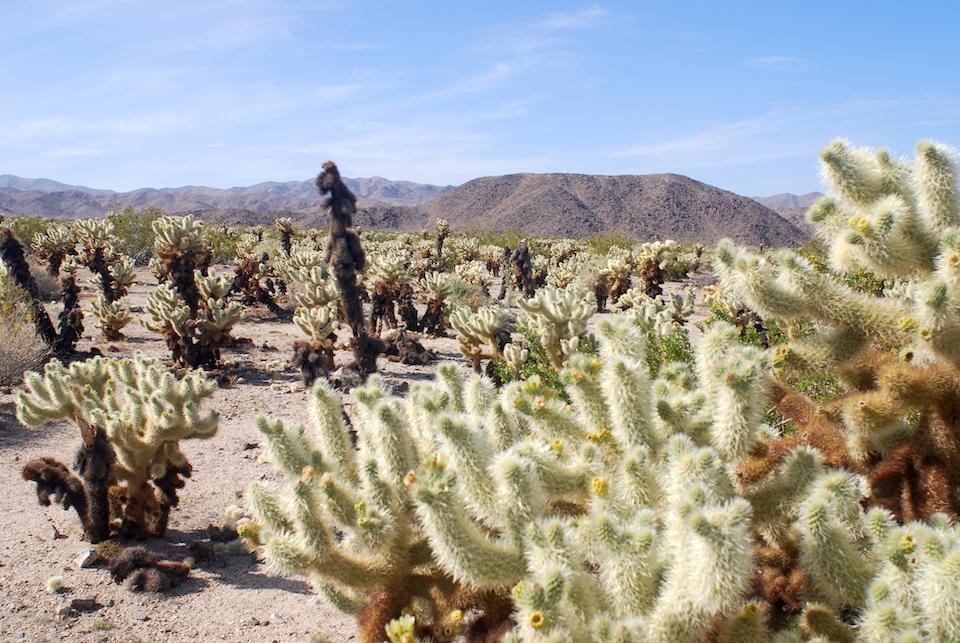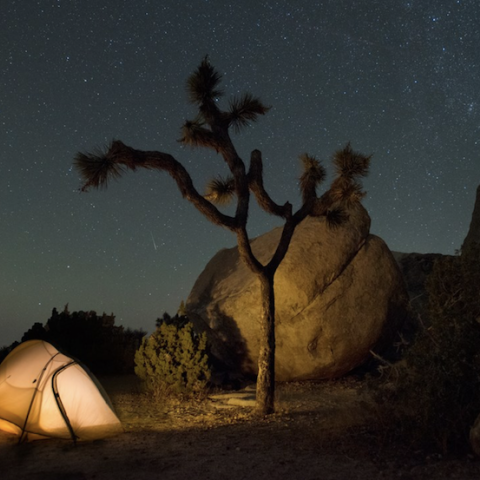
Joshua Tree National Park is as enticing once the sun goes down as it is in daylight/NPS, Lian Law
Straddling the geographic divide that splits the Mojave Desert from an element of the Sonoran Desert, Joshua Tree National Park is a geologic and botanical showcase that is a climber's gymnasium. But it also can be an unforgiving landscape, one that has claimed more than a few lives.
The desert beauty is the main attraction for most heading to Joshua Tree, from the contorted and spiky Joshua trees and the flame-red blossoms of the ocotillo to the cholla bushes with their barbed spikes that you won't soon forget.
The park has two decidedly different desert settings that are responsible for the diverse vegetation. The northern half of the park is laid down across a portion of the Mojave Desert, while the southern half covers part of the Colorado Desert, which itself is a component of the larger Sonoran Desert. A rough dividing line between the Mojave and Colorado deserts in the park is Wilson Canyon, through which the Pinto Basin Road runs. The Mojave is a higher, cooler desert than the Colorado Desert and more attractive to Joshua trees, Mojave yuccas, even pinyon pines, scrub oaks, and junipers. The Colorado Desert lies below 3,000 feet in elevation and is hotter than the Mojave. This setting is more favorable for cholla, ocotillo, and creosote bush.
The Joshua trees certainly deserve the attention they receive. Despite their thick trunks and contorted branches capped by spikes of green, these trees once were thought to be members of the lily family. In the end, though, botanists settled on the yucca as the lineage of the Joshua trees.

Ocotillo starting to bloom in Joshua Tree/Kurt Repanshek
And the name? That descends from the Church of Latter-day Saints, also known as the Mormons. As they headed south from the Salt Lake Valley in Utah, missionaries encountered this unique-looking trees near present-day St. George, Utah, and, seeing a form of supplication in their shape, named them "Joshua" trees.
So many plant species -- 813 species of vascular plants, according to park officials -- live in this seemingly harsh landscape that one name under consideration for this park was Desert Plants National Park.
Joshua Tree started out as a national monument in 1936, when President Franklin Delano Roosevelt set it aside to protect not just its namesake trees but the other desert flora and fauna found here. While FDR set aside 825,340 acres for the monument, 14 years later Congress transferred 289,500 acres out of the monument and back into the public domain for mining and grazing.
In 1994, however, the California Desert Protection Act returned that land back to the monument and redesignated Joshua Tree as a national park. Then, between 1999 and 2000, another 25,000 acres of land within the park's boundaries that had been privately owned were added to the park as part of the purchase by the federal government and the Wildland Conservancy of more than 600,000 acres from the Catellus Corporation.
Though the park might appear too rough and rugged to sustain life, people have been living in and around the area for at least 5,000 years, according to the National Park Service. The first group known to inhabit the area was the Pinto Culture, followed by the Serrano, the Chemehuevi, and the Cahuilla. Perhaps leaving the greatest impact on the landscape were prospectors.
In his book, The National Parks, Freeman Tilden wrote that, "(T)he jackass prospector has gophered everywhere among the hills. Some rich finds were made, but in most cases the ores were not rich enough to pay for hauling them to faraway mills for reduction."
Cattlemen came to the park in the later half of the 19th century to graze their cattle and tap springs to water them.
What can you do at Joshua Tree?
The geologic rubble in varying stages of decomposition makes Joshua Tree a frequent destination for those who enjoy bouldering or honing their skills on granite walls and outcrops. Youngsters are drawn to the mazes of some of these boulder fields for games of hide and seek, while campers seeking a weekend reprieve from the city and work find the campgrounds with their rock backdrops perfect.
Those geologic outcrops, by the way, got their start deep underground via volcanic machinations. It was the upward pumping of monzogranite -- a particular form of molten rock -- that eventually gave birth to the landscape that now greets visitors. Geologic fault zones are key to Joshua Tree, for they bring life-saving water to the surface in the form of springs. These springs, in turn, create oases that nourish vegetation and wildlife. The Pinto Mountain Fault wraps the northwestern lobe of the park, the San Andreas Fault undercuts the southern boundary, and the Blue Cut Fault traverses the center of the park from west to east.

The Cholla Garden at Joshua Tree offers a nice hike through the cacti/Kurt Repanshek
Of the 158 desert fan palm oases in North America, five are located within the national park. Among the more notable oases at Joshua Tree is the 49 Palms Oasis. Another is the Oasis of Mara at the visitor center in Twentynine Palms that marks the Pinto Mountain fault. Bighorn sheep, Gambel's quail, and coyotes are among the wildlife drawn to the oases.
Joshua Tree is also a great destination for birders any time of year. Depending on the season you visit, you might see roadrunners, mockingbirds, a variety of wren species, raptors such as kestrels and red-tailed hawks, dark-eyed juncos, orioles, bluebirds, and even robins.
There are eight front-country campgrounds (nine when you consider the Sheep Pass group campground) in Joshua Tree National Park. That might not seem like many for a park of nearly 800,000 acres, but combined they offer nearly 500 campsites. Just one campground, Cottonwood, is in the southern section of the park. All the rest -- White Tank, Bell, Jumbo Rocks, Ryan, Sheep Pass, Hidden Valley, Indian Cove, and Black Rock -- are somewhat squeezed into the northern half above Wilson Canyon.

Joshua Tree at sunset/NPS, Brad Sutton
Campfires are indeed nice, but all vegetation in the park is protected. As a result, if you want to relax before a flickering campfire at day's end, you need to bring your own wood to burn.
Hiking amid the oddly shaped Joshua trees, past clusters of cacti, and through mazes of rock rewards with both wonders right in front of your eyes as well as gorgeous far-off vistas. But you need to be prepared for wandering in this desertscape. Getting lost or suffering from the heat are two very real scenarios you must prepare against. Good maps, plenty of water and shielding from the sun, and letting folks know where you're heading are elements of your hike not to be overlooked.
As spectacular as the days can be in the park, so, too, are the nights. As flames from campfires leap skyward as day ends, the park's night skies take over, revealing the cosmos in spectacular clarity thanks to the relative lack of light pollution at this International Dark Sky Park.
This is a fascinating national park, one best visited during the winter months when the temperatures have moderated from summer's highs in the triple-digits.


 Support Essential Coverage of Essential Places
Support Essential Coverage of Essential Places







Comments
I lived on Indian Cove Road for Tweny years. Sure do miss it, and in the Spring when the wild flowers bloom us spectacular!
What an amazing article! Joshua tree ward love at first sight, in 2012 for me. As a result we actually moved here in 2016.
You have described it so accurately and beautifully!